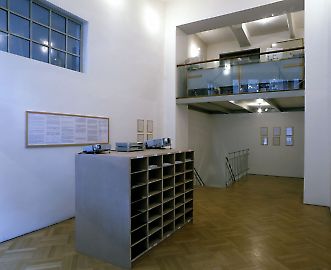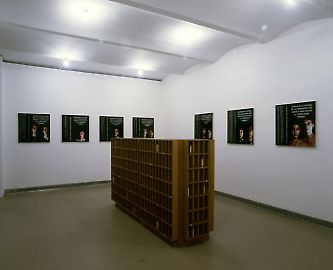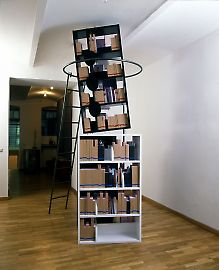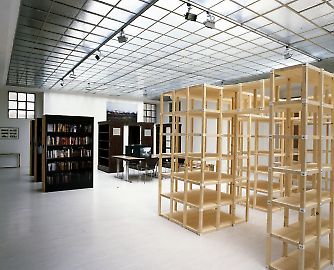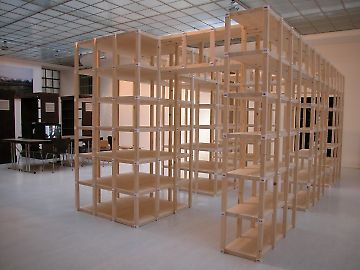Clegg & Guttmann -- Social Sculpture, Community Portraits and Spontaneous Operas 1990 – 2005
The exhibition Social Sculptures, Community Portraits and Spontaneous Operas 1990 – 2005 collects together a variety of artworks derived from the entire range of the public projects of Clegg & Guttmann, from 1990 to 2005. Each of the pieces in the show began as a special project made in situ. These projects were reorganized at a later point, recontextualized and new works of art were made on this basis. Each of the pieces in the show demonstrates a different recontextualization strategy; each bears a different relation to the original project from which it was derived.
A social sculpture is a work of art which engages a variety of different institutions, cultural forms and ideational structures, some artistic and some not and combine them in a manner designed to give the viewer the possibility of reflecting on the relations between them. The Social sculpture reveals the nature of the art institutions by comparing them with others and by studying their place in the system. By doing so it shows the place of art within the larger framework, which surrounds it.
Community portraits are devises, which elicit the responses of a community, record them and organize the data in a special form designed for contemplation on one’s identity as a member of a community and of the history of that social entity. The term ’Spontaneous Opera’ describes – under the category of events – works of art in the public domain which function as mechanisms for generating instant communitarian self-representations.
In a Spontaneous Opera the community presents itself to itself with songs, dances, speeches and other forms of performativ behaviour, which the work of art elicits from the participants and then records for their benefit.
The term Spontaneous Opera applies to those of our projects, which we regard primarily as events. By contrast, the term Social Sculpture subsumes them under the category of objects, in an appropriately extended sense of the term. A third way to classify our projects is to view them as Community Portraits in which case they are deemed intentional actions which are concerned with representation. Many of our projects, perhaps most, can be viewed as objects, actions or events depending on the context. The three terms thus do not stand for essential qualities of the work itself but for the different attitudes of their producers or receivers. Some projects are enclosed in an interval of time and within an area in space; others opens up a trajectory of events which take place consecutively or simultaneously, in a single location or not. Certain projects are re-contexualizations of others, in one of the many significations of the term. The following is a list of examples to a variety of recontextualization strategies.
In some cases, when the material gathered is inherently interesting, we collect it and display it as an independent work of art. Aided by an appropriate background presentation, the entire body of the material related to the original project is gathered together in an environment dedicated to their study. This is how we conceived The Music Library of Unite d’Habitation, Firminy, for example. It is a music library containing items collected from the inhabitants of the Le Corbusier building which is displayed in a special cabinet. The same is true of Sha-at-nez, an installation based on a specialized library dedicated to the concept of displacement, which we constructed in the Freud Museum in 2004. In the same category is also The Moebius Library, originally constructed as a presentation object for the Waldzell Seminar in the monastery of Melk.
Another category of re-contextualizations are those where the same procedures of the original project, or similar ones, are applied, again, and the new results are combined together with the earlier ones. This is the case of The Lost Letter, for example. It is a part of the Recontextualization of the Sick Soul, a project based on a series of venues we developed in the mid nineties. In this case we activated a possibility envisaged in Sick Soul I-IV but never actualized.
The Seven Bridges of Königsberg is an installation based on a partial selection from the themes of the original project, an Open Public Library which operated in Duisburg in connection with the exhibition Kant Park which took place in the Lehmbruck Museum in 1999. The structure of this library is based on a diagram of the seven bridges of Königsberg. The mathematician Euler proved that one cannot cross all the bridges, each only once and, without gap or overlap, return to the point of origin. As a consequence, the books in the library, whose structure is based on the same diagram, cannot be arranged alphabetically, from A to Z, when all the shelves are full. This is a library, which resists order, an anarchist library, if we may. Based on the original project we designed a new installation, which emphasizes the mathematical properties of the structure in virtue of which it cannot be ordered.
The work entitled The Open Public Library in Graz 1990-2005 is the culmination point of the seminal project of this oeuvre. It is derived from the material involved in the original project in 1991, from a work made in 1993 entitled The Re-contextualization of the Open Public Library of Graz and it includes supplementary material related to both. This work demonstrates how complex the mechanism involved in re-contextualization can become. Each of the elements of the work is, at the same time, a part of a social sculpture, an aspect of a portrait and a relic of a seminal event. Thus the project is restructured, continuously, in the mind of the viewer from a sculpture, to a portrait and than to the opera and than back again. The elements of the installation are also stratified into three different time periods and their characteristics fluidly shift along the functional the informational and the symbolic dimensions.


